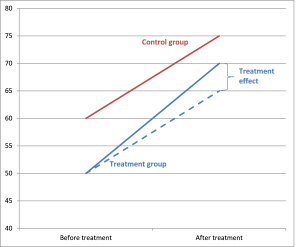Difference-in-Differences
How it works
Difference-in-differences (DID) is a quasi-experimental design. The idea is that the difference between treatment and control groups in the change from pre- to post-treatment can be interpreted as the effect of the treatment. The general structure of the DID is presented in the table and the figure below.
As the table above shows, DID can be calculated as the difference between the two groups in the changes in time of the group means.
Treatment effect in the Difference-in-Differences design
This figure shows the effect of the treatment as the difference between what the outcome would have been in absence of the treatment (see the dashed line that is parallel with the red control group line) and what the outcome actually was with treatment.
Note that DID has very good internal and external validity, as it controls for many unobservable characteristics:
- All characteristics (besides the treatment itself) that change the outcome for both groups from before to after the treatment (the slope of the red and the dashed lines), and
- All characteristics that make the two groups different before the treatment, and that do not change from before to after the treatment (the distance between the red and the dashed lines).
When to use
It is most commonly applied in studies where there is a treatment and a control group, and data are available on both groups’ outcome measures from before and after the treatment. Units are not necessarily randomly assigned to treatment and control groups. For example DID could be applied to estimate the differential effects of different state policies on individuals living on opposite sides of state borders, but close to each other.



